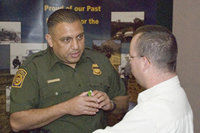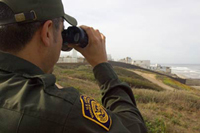Border Patrol Recruiter
Home | Contact | Training Academy | Border Patrol Job Fairs | Salary/Pay and BenefitsBorder Patrol Training Academy
Training at the Border Patrol AcademyThe CBP Border Patrol Academy is recognized as having one of the most challenging curriculums in federal law enforcement. All newly hired Border Patrol Agents receive their basic law enforcement skills by attending the Academy. Each Border Patrol Agent trainee must complete a 19-week resident course of instruction in integrated law, physical training, firearms instruction, driving and Spanish. Border Patrol trainees must maintain a passing score in all courses of instruction in order to be retained. Law CoursesThe Academy law program consists of four (4) separate courses. Successful completion of the combined courses requires the trainee to attain a minimum overall average of 70%.
Spanish CoursesSpanish Language Training enables trainees to communicate effectively with those people they will encounter in the field who speak only Spanish. This is a critical element of the job because over 90% of the more than one million undocumented aliens apprehended each year speaks only Spanish. The Spanish taught at the Border Patrol Academy is very specialized. Our staff provides an 8-week Task-Based Language Training program that is focused on critical Border Patrol-specific tasks. Soon after arriving for 55-days of basic academy training, all students are tested on their language abilities. Those who fall below a benchmark score that has been established by the language training experts and Academy subject matter experts are assigned a Spanish class that will begin upon successful completion of the 55-day program, while proficient Spanish speakers will report directly to their duty stations to begin Post Academy Training. Students must be able to understand and employ law enforcement-specific language unique to the Border Patrol Agentís work environment as well as be able to solicit information and use colloquial phrases and idiomatic expressions. Instructors use a wide variety of the most modern methods available in second language acquisition methodology to provide students with an exciting, creative, and challenging course that will enable them to remain safe and effective in the field. Border Patrol OperationsThe Border Patrol Academy Operations program consists of FLETC Police Training instruction plus operations courses instructed by Border Patrol personnel. To successfully complete the operations portion of the Border Patrol Academy, trainees must attain an overall grade of 70% in the combined subject areas. The FLETC Police Training courses will be tested at the midterm point, and a final exam will be given at a later point in the course. A minimum score of 70% is needed to pass these exams. Firearms TrainingFirearms training is designed to instruct the trainee in range safety, survival shooting techniques, judgment pistol shooting, quick point, and instinctive reaction shooting. Both classroom and range practice sessions are utilized. Should a trainee fail to successfully complete the Academy Firearms Program, he/she will be afforded eight (8) hours of remedial training followed by a two (2) hour re-qualification session. Physical TrainingPurpose: The purpose of the Physical Training Program at the Border Patrol Academy is fourfold:
Philosophy: The philosophy behind the aforementioned purpose has been developed due to the nature of the Border Patrol Agent's duties. The job or primary function of the Patrol agent is to apprehend violators of the immigration and nationality laws, both at and after entry. Secondly, due to our presence in the border areas, we frequently encounter and apprehend smugglers of both aliens and narcotics. The majority of agents perform their duties in rural areas, often on foot, and many times must respond to potentially dangerous situations by themselves without benefit of assistance. This fact, in itself, requires each patrol agent to be prepared, both psychologically and physically, to deal with armed and dangerous persons. Final Test: Border Patrol Agent trainees will be required to take a final test. Testing is accomplished during a two hour Physical Training class. Failure in any portion of the Final Test is failure of the course. Border Patrol Agent trainees must successfully pass the entire test during one class period to graduate from the Academy. The test consists of three timed events. The following is a list of the three events and their maximum times.
Drivers TrainingThe Drivers Training program is designed to train Border Patrol Agent trainees in the safe and efficient operation of motor vehicles. Emphasis is placed on principles and techniques relating to laws of motion, vehicle dynamics and driver response. Under close supervision and guidance, the trainees will learn to recognize their personal limitations as well as limitations of the vehicle. The Border Patrol is charged with the prevention of illegal entries in the expanses between the Ports of Entry as well as the apprehension of illegal aliens anywhere within the U.S. The safe operation of patrol vehicles under a variety of extreme conditions is vital to the accomplishment of the Service mission. The Drivers Training branch is tasked with providing trainees with the necessary skills to become effective border patrol agents. The following three areas of instruction must be successfully completed in order to graduate from the Border Patrol Academy:
Once the trainee has successfully completed the pass/fail portion of the program, he or she will be given further advanced instruction in the areas of:
|
Request More Info |
Fill out the form below and you'll get information on how to apply, your local recruiter office contact information, and answers to your questions about the Border Patrol Agent hiring process. * All fields are required |
 Recruiters can answer your questions about the job. |
